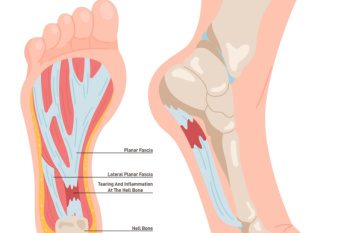Connect With Us
Blog
Items filtered by date: February 2024
Ease Painful Feet With Orthotics

Custom orthotics can be used to relieve foot pain and discomfort. They're also used to treat various foot conditions and deformities. Flat feet, bunions, and Morton's neuroma are just a few of the foot conditions that have been known to benefit from the use of orthotics.
Comfy feet are happy feet! Contact us today.
Dealing With an Achilles Tendon Rupture

In cases of a complete tear of the Achilles tendon, surgery becomes a necessary consideration. This procedure involves carefully bringing the torn ends of the tendon together and stitching them to promote healing. While Achilles tendon repair surgery is generally safe, it's not without risks. Complications can include nerve damage, foot swelling, and issues with blood flow. Further, there's a slight risk of re-rupture, emphasizing the need for thorough post-operative care and rehabilitation. Following surgery, diligent pain management and adherence to post-operative instructions are essential for a smooth recovery. This typically includes wearing a cast or splint, elevating the leg, and gradually reintroducing activities over several months. Full recovery can take up to nine months. If you believe you have torn your Achilles tendon injury or have concerns about treatment options, it is suggested that you contact a podiatrist immediately for an exam, a diagnosis, and treatment options.
Achilles tendon injuries need immediate attention to avoid future complications. If you have any concerns, contact Scott Amoss, DPM of Advanced Foot & Ankle Specialists. our doctor can provide the care you need to keep you pain-free and on your feet.
What Is the Achilles Tendon?
The Achilles tendon is a tendon that connects the lower leg muscles and calf to the heel of the foot. It is the strongest tendon in the human body and is essential for making movement possible. Because this tendon is such an integral part of the body, any injuries to it can create immense difficulties and should immediately be presented to a doctor.
What Are the Symptoms of an Achilles Tendon Injury?
There are various types of injuries that can affect the Achilles tendon. The two most common injuries are Achilles tendinitis and ruptures of the tendon.
Achilles Tendinitis Symptoms
- Inflammation
- Dull to severe pain
- Increased blood flow to the tendon
- Thickening of the tendon
Rupture Symptoms
- Extreme pain and swelling in the foot
- Total immobility
Treatment and Prevention
Achilles tendon injuries are diagnosed by a thorough physical evaluation, which can include an MRI. Treatment involves rest, physical therapy, and in some cases, surgery. However, various preventative measures can be taken to avoid these injuries, such as:
- Thorough stretching of the tendon before and after exercise
- Strengthening exercises like calf raises, squats, leg curls, leg extensions, leg raises, lunges, and leg presses
If you have any questions please feel free to contact our offices located in Whiting and Toms River, NJ . We offer the newest diagnostic tools and technology to treat your foot and ankle needs.
Key Insights Into Foot Pain From Plantar Fasciitis

Plantar fasciitis, a common foot ailment, affects millions of individuals worldwide, causing discomfort and hindering mobility. This condition occurs when the plantar fascia, a thick band of tissue connecting the heel bone to the toes, becomes inflamed or strained. It is characterized by sharp pain at the bottom of the foot, particularly near the heel, especially noticeable during the first steps in the morning or after prolonged periods of rest. While the exact cause remains elusive, factors such as overuse, improper footwear, high-impact activities, and tight calf muscles contribute to its onset. Plantar fasciitis is prevalent among athletes, runners, and individuals who spend extended periods on their feet. Fortunately, conservative treatments like rest, stretching exercises, and orthotic inserts, can alleviate symptoms and promote healing in many cases. However, persistent cases may require medical intervention, including corticosteroid injections or surgical procedures. If you have heel pain, it is suggested that you confer with a podiatrist who can accurately diagnose and treat plantar fasciitis.
Plantar fasciitis can be very painful and inconvenient. If you are experiencing heel pain or symptoms of plantar fasciitis, contact Scott Amoss, DPM from Advanced Foot & Ankle Specialists. our doctor can provide the care you need to keep you pain-free and on your feet.
What Is Plantar Fasciitis?
Plantar fasciitis is the inflammation of the thick band of tissue that runs along the bottom of your foot, known as the plantar fascia, and causes mild to severe heel pain.
What Causes Plantar Fasciitis?
- Excessive running
- Non-supportive shoes
- Overpronation
- Repeated stretching and tearing of the plantar fascia
How Can It Be Treated?
- Conservative measures – anti-inflammatories, ice packs, stretching exercises, physical therapy, orthotic devices
- Shockwave therapy – sound waves are sent to the affected area to facilitate healing and are usually used for chronic cases of plantar fasciitis
- Surgery – usually only used as a last resort when all else fails. The plantar fascia can be surgically detached from the heel
While very treatable, plantar fasciitis is definitely not something that should be ignored. Especially in severe cases, speaking to your doctor right away is highly recommended to avoid complications and severe heel pain. Your podiatrist can work with you to provide the appropriate treatment options tailored to your condition.
If you have any questions please feel free to contact our offices located in Whiting and Toms River, NJ . We offer the newest diagnostic and treatment technologies for all your foot and ankle needs.
Types of Ankle Fractures

Ankle fractures can be grouped into two types, stable and unstable. The three parts of the ankle are the inner bump, or medial malleolus, the outer bump, or lateral malleolus, and the back bump, also known as the posterior malleolus. If only one bump is broken, it is usually a stable fracture. But if two or more bumps are broken, it is considered to be an unstable fracture and may need surgery. If you have a broken outer bump, you may wear a special boot or splint. For other ankle fractures, you will likely need a splint on the back of your leg and another one around your ankle. Rest and keeping your weight off the injured foot, in addition to using crutches might be needed. Some people may continue using crutches even after wearing the boot until they can put weight on the foot without pain. If you have broken your ankle, it is suggested that you schedule an appointment with a podiatrist for a diagnosis, including the type of fracture you have sustained, and proper treatment for you.
Broken ankles need immediate treatment. If you are seeking treatment, contact Scott Amoss, DPM from Advanced Foot & Ankle Specialists. our doctor can provide the care you need to keep you pain-free and on your feet.
Broken Ankles
A broken ankle is experienced when a person fractures their tibia or fibula in the lower leg and ankle area. Both of these bones are attached at the bottom of the leg and combine to form what we know to be our ankle.
When a physician is referring to a break of the ankle, he or she is usually referring to a break in the area where the tibia and fibula are joined to create our ankle joint. Ankles are more prone to fractures because the ankle is an area that suffers a lot of pressure and stress. There are some obvious signs when a person experiences a fractured ankle, and the following symptoms may be present.
Symptoms of a Fractured Ankle
- Excessive pain when the area is touched or when any pressure is placed on the ankle
- Swelling around the area
- Bruising of the area
- Area appears to be deformed
If you suspect an ankle fracture, it is recommended to seek treatment as soon as possible. The sooner you have your podiatrist diagnose the fracture, the quicker you’ll be on the way towards recovery.
If you have any questions, please feel free to contact our offices located in Whiting and Toms River, NJ . We offer the newest diagnostic and treatment technologies for all your foot care needs.
Definition of Partial and Total Nail Avulsion

When grappling with the discomfort of ingrown toenails, partial and total nail avulsion emerges as a viable solution. Partial nail avulsion involves the removal of a portion of the affected nail, addressing the ingrown edge, and providing relief. This procedure aims to eliminate the problematic segment while preserving the overall integrity of the nail. Conversely, total nail avulsion involves completely removing the toenail, offering a more comprehensive approach to severe or recurrent ingrown toenails. Both procedures are typically performed under local anesthesia to minimize discomfort. Proper postoperative care is vital to promote healing and prevent complications following avulsion. Understanding the differences between partial and total nail avulsion allows individuals to make informed decisions in collaboration with podiatrists. If you have developed an ingrown toenail, it is strongly suggested that you are under the care of a podiatrist who can determine if one of these types of surgery is right for you.
Ingrown toenails may initially present themselves as a minor discomfort, but they may progress into an infection in the skin without proper treatment. For more information about ingrown toenails, contact Scott Amoss, DPM of Advanced Foot and Ankle Specialists. our doctor can provide the care you need to keep you pain-free and on your feet.
Ingrown Toenails
Ingrown toenails are caused when the corner or side of a toenail grows into the soft flesh surrounding it. They often result in redness, swelling, pain, and in some cases, infection. This condition typically affects the big toe and may recur if it is not treated properly.
Causes
- Improper toenail trimming
- Genetics
- Improper shoe fitting
- Injury from pedicures or nail picking
- Abnormal gait
- Poor hygiene
You are more likely to develop an ingrown toenail if you are obese, have diabetes, arthritis, or have any fungal infection in your nails. Additionally, people who have foot or toe deformities are at a higher risk of developing an ingrown toenail.
Symptoms
Some symptoms of ingrown toenails are redness, swelling, and pain. In rare cases, there may be a yellowish drainage coming from the nail.
Treatment
Ignoring an ingrown toenail can have serious complications. Infections of the nail border can progress to a deeper soft-tissue infection, which can then turn into a bone infection. You should always speak with your podiatrist if you suspect you have an ingrown toenail, especially if you have diabetes or poor circulation.
If you have any questions, please feel free to contact our offices located in Whiting and Toms River, NJ . We offer the newest diagnostic and treatment technologies for all your foot care needs.
